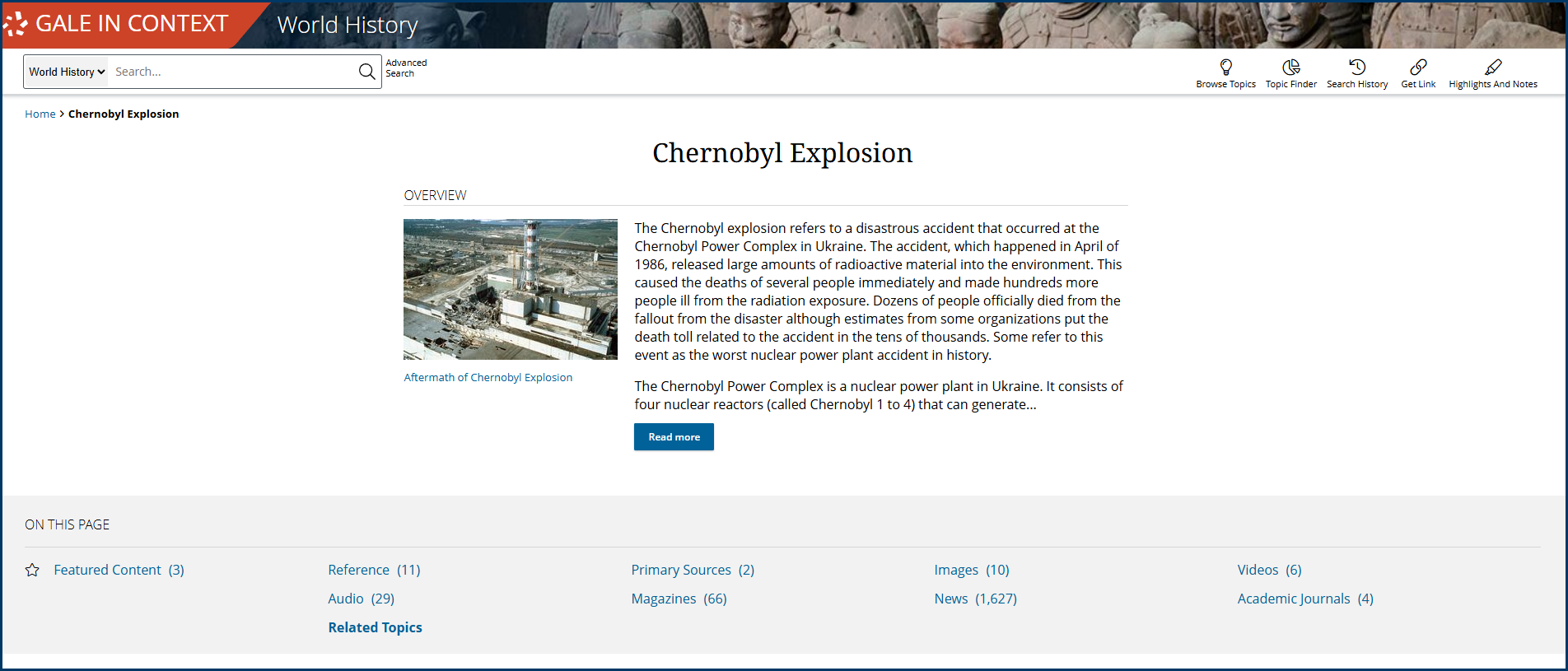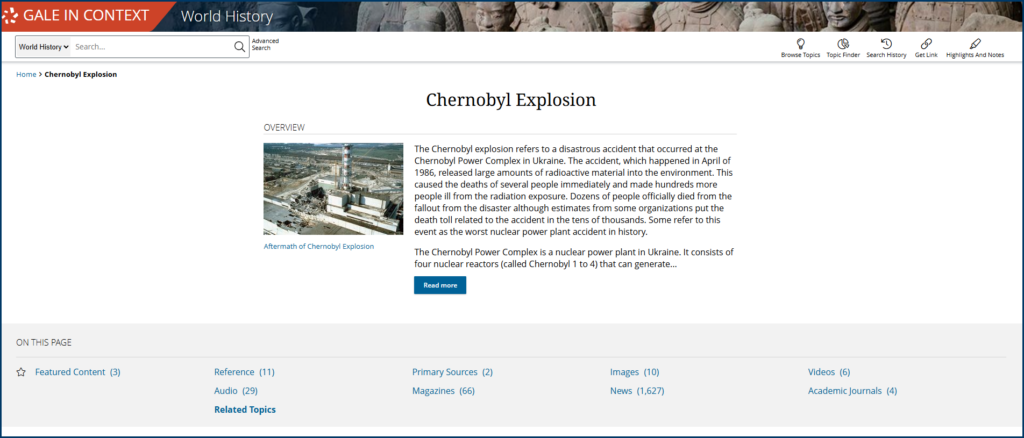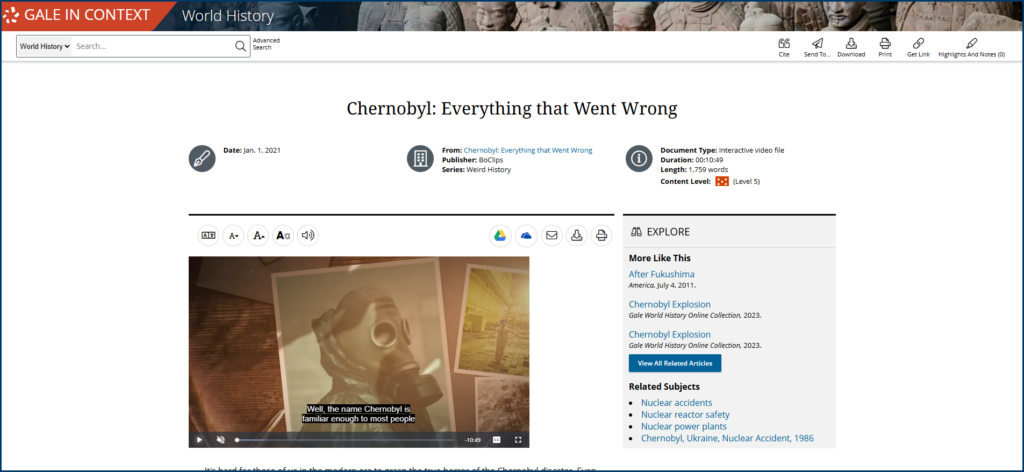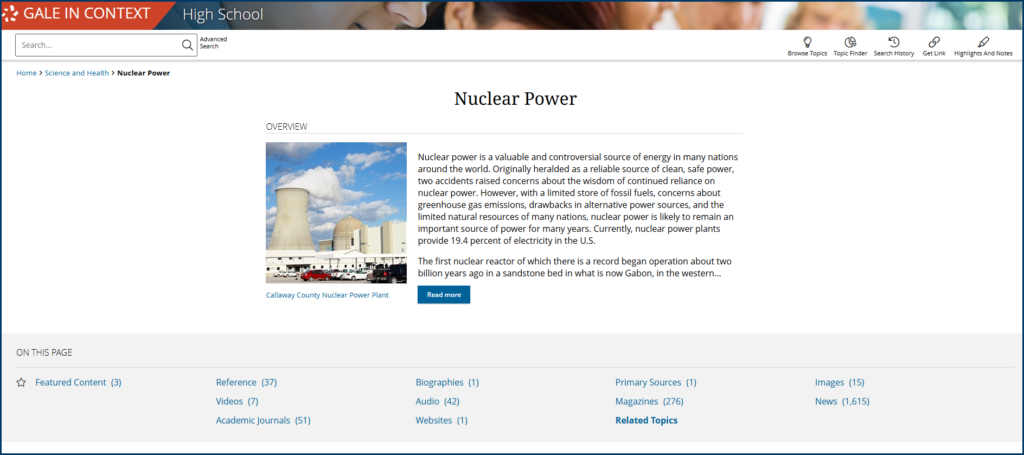| By Gale Staff |
On April 26, 1986, the Chernobyl Power Complex in Ukraine became ground zero for the worst accidental nuclear plant disaster in the world. While only two workers perished in the immediate aftermath, hundreds more suffered injuries and radiation exposure, which led to dozens of deaths.
Nearly 40 years on, the April 26 is honored as Chernobyl Disaster Remembrance Day. For students who may be unfamiliar of the event, this is an important opportunity to introduce what happened, the impacts across Europe and the former Soviet Union, and far-reaching ramifications—including in the conflict between Russia and Ukraine.
Guide your class through how events unfolded with Gale In Context: World History. This database gives students access to primary resources, articles, audio, video, and other media, enabling them to get a play-by-play understanding of what took place, and a comprehensive analysis from a historical perspective.
Understand What Caused the Chernobyl Disaster
Situated near the border with Belarus, the former Chernobyl Power Complex is located in Ukraine, about three kilometers from the city of Pripyat. The facilities included four nuclear reactors, Chernobyl 1 through 4.
On April 25, 1986, the day before the disaster, employees at Chernobyl 4 were preparing for a routine test to determine the turbines’ ability to function during a power failure. During the test the next day, however, an unexpected power surge set off a chain reaction in the core of Chernobyl 4. The first of two explosions occurred, stemming from steam buildup in the reactor, followed by another explosion seconds later.
The Chernobyl explosions caused several fires and structural damage, lifting the reactor’s concrete lid and thereby releasing radioactive material into the atmosphere. The blasts killed one worker immediately; another died hours later from injuries. About 100 more workers became sick from radiation poisoning.
Follow the Emergency Responses
Emergency squads worked to put out the fires at Chernobyl 4 and contain the spread of radioactive material to prevent further radiation exposure. Unfortunately, many of these first responders suffered severe radiation sickness.
On April 27, authorities evacuated about 45,000 people from nearby Pripyat. In the following weeks, plant leadership attempted to contain the heat and took other measures to prevent further damage and radiation leaks. They began construction of a sarcophagus around the plant to shield the surrounding areas from further contamination, eventually completing it in December 1986.
The Soviet government restricted access to the 30-kilometer radius around the plant and in the months and years that followed, ordered an additional 300,000 people to evacuate nearby locations.
Initial clean-up and recovery continued through 1987 with the help of response workers known as Chernobyl liquidators. The efforts involved removing scattered fuel and shrapnel from surrounding buildings, digging up radioactive plants and soil for burial in trenches, using chemicals to scrub away contamination from the plant and nearby buildings, and relocating radioactive waste to underground sites.
From 2016 through 2018, an additional structure, the Chernobyl New Safe Confinement, went up around the Chernobyl 4 sarcophagus to allow for continued steps to decommission the plant, likely to continue through 2065.
The Far-Reaching Effects of Radiation Contamination
As time passed and more liquidators participated in the recovery, radiation exposure became less severe. However, the disaster’s toll was undeniable and far-reaching.
By the end of 1986, a total of 28 people had died from acute radiation syndrome (ARS). Other victims included about 4,000 people with thyroid cancer, most of whom were children and adolescents. Although there were nine fatalities, reports from Belarus estimated a nearly 99 percent survival rate.
Workers involved in the earlier stages of the post-disaster efforts suffered high levels of radiation exposure. In its early stages, ARS typically presents symptoms like loss of appetite, vomiting, and nausea. In fatal cases, sickness can last several months before death.
The impacts of radiation sickness led to widespread mistrust of governmental and medical professionals. It also stoked fears of radiation-related congenital conditions, although no links were found between radiation exposure from Chernobyl and effects on unborn fetuses.
According to final estimates, more than 500,000 liquidators were involved in the long-term recovery and clean-up. The overall costs to the Soviet government have been estimated at $230 billion.
Identify the Disaster’s Effects and Historical Implications
The Chernobyl disaster had numerous long-term environmental and policy-related impacts. To unpack and understand them, turn to Gale In Context: World History with confidence that the material is reliable, and thoroughly vetted by our team of experts. Bring the story to life with a wealth of reference materials, biographies, videos, images, and more.
Understand the Environmental Impacts on Multiple Countries
Concentrated heavily around Ukraine, Belarus, and Russia, the Chernobyl disaster impacted a wide swathe of Europe.
The land within a 30-kilometer radius of the plant became known as the Exclusion Zone, where abandoned cities (including Pripyat) and farmland remained uninhabited. The Soviet government guarded this area heavily and restricted public access due to the high radiation levels.
In 2011, the Ukrainian government opened the Exclusion Zone as a tourist site for visitors over 18. Nevertheless, the area’s soil contains so much plutonium that experts estimate the area will remain uninhabitable for 20,000 years.
Recognize the Calls for Greater Safety Standards
After the Chernobyl disaster, many European nations called for greater transparency and attention to the radiation exposure—partly due to the Soviet Union’s initial efforts to cover up the accident. Global leaders and ecological organizations also pushed for enhanced international collaboration to address environmental harms and human health risks of nuclear power. They also stressed the need for stronger regulations and safety standards.
Curious to learn more about the Chernobyl disaster? Read on with Gale In Context: World History.
Engage Your Students with the Lessons from Chernobyl
Although there is still debate about the number of lives lost and the extent of the damage, to date, the 1986 Chernobyl crisis widely considered the worst nuclear disaster in history. What happened at Chernobyl can teach many historical, political, scientific, and other lessons in today’s classroom. Facilitate a deeper exploration of events from a variety of perspectives with the following activities.
Explore the Fall-Out in International Relations
Assign students governmental and other decision-making roles and discuss how they would have responded to the crisis. Incorporate a map of Ukraine and Europe, and with students carrying out their roles, have them trace the progression of the accident and its effects on other countries.
Ask students to ponder these additional questions:
- What effects did the spreading of the contamination have on international relations and the actions of Soviet President Mikhail Gorbachev and other European leaders?
- How did the geographic spread influence other countries’ responses and diplomatic efforts?
- How did the Cold War impact the nuclear power industry and the events contributing to the Chernobyl accident?
Dig Deeper to Find Crucial Facts
Send students on a quest for eye-popping facts about the disaster. For example, temperatures inside the reactor during the explosions reached 2,600 degrees Celsius, multiple times hotter than molten lava.
Expand your search by turning to Gale In Context: High School to learn more about nuclear power or Ukraine, including insights into how Chernobyl has had a part to play in the war between Russia and Ukraine. Explore Gale In Context: Biography to uncover insights about world leaders like Nikolai Ryzhkov, de facto Soviet prime minister at the time of the disaster.
Understand the Disaster Through Real-Life Accounts
Have students read the first-hand accounts of historians, writers, and journalists. For example, Svetlana Alexievich, a Belarusian Nobel Prize laureate, captured the disaster in Voices from Chernobyl, a compilation of stories from the plant workers, families, and citizens who lived through it.
Consider having students write reflection pieces based on what they’ve read, or lead an in-class discussion.
- In what ways does your class think the children’s coping methods might have been different from their parents and other adults?
- What thoughts do students have about nuclear energy today?
- What are the implications of living near nuclear power plants in light of the disasters at Chernobyl and, more recently, Fukushima?
Partner with Gale to Enhance Student Learning
At Gale, we help teachers make learning more engaging for students. Gale provides the necessary context understand the world we live in today, and the events that helped shape it. Step into history with a wealth of resources and tools tailored for a range of learning needs and abilities.
Contact one of our education consultants to learn about all the extensive Gale resources that can boost your impact in the classroom.




